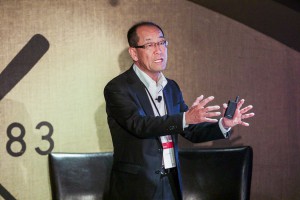
Toyota's Yoshikazu Tanaka, the chief engineer of the Mirai fuel-cell vehicle, confirmed Toyota's commitment to fuel cell vehicles.
Japan is gearing up to put 800,000 vehicles powered with fuel cells on the road by 2030.
Japanese experts from business and academia outlined Japan’s fuel-cell push at the “Coping with Change: Global Warming and Decarbonization,” an international symposium organized by Venice International University and Alcantara, the Milan-based maker of luxury fabric used for automotive interiors. Japan’s fuel cell push has the support of the Japanese government.
Yasuhiro Daisho, senior research professor at Waseda University and an emeritus researcher for Japan’s Next Generation Vehicles Research Council, offered a broad overview of the goals set out by Japanese industry and Japanese government.
While critics, starting with Tesla’s Elon Musk have derided fuel cells as workable, the Japanese government, starting Prime Minister Shinzo Abe, has made their development a priority in recent years.
(To get our early driving impressions on Hyundai’s Nexo fuel-cell vehicle, Click Here.)
“We have serious issues with mobility,” said Daisho, who noted that Japan has had to endure three oil shocks during the past 45 years. “We have to electrify vehicles,” he said, while also dramatically improving the efficiency of internal combustion engines.
At the same time, Japan is pushing the ahead with development of fuel cell electric vehicles that convert hydrogen into electricity to power vehicles motors. The effort also calls for the development of a network of hydrogen fueling stations to service what is expected to be a growing fleet of fuel cell vehicles.
By 2020, Japan expects to have 40,000 FCEVs on the road and 200,000 on the road by 2025 and 800,000 by 2030, he said. Japan is also developing a network of hydrogen fueling stations and expects to have 160 ready by 2020 and 320 or more by 2025 and 720 in place by 2030, Daisho said.
The Japanese government has committed substantial resources to the effort, added Daisho, who estimated that emissions from vehicles around the world could be cut by 80% by 2050 with a fleet that that was made of 50% ICE engines, 45% EV and 5% FCEVs, he said. The shift will be aided by shift to batteries that have two to three times the density of current batteries, Daisho added.
Hirohide Furutani, director of the Renewable Energy Research Center in Fukushima, Japan, said one of the projects his teams have focused on is using solar photo voltaic cells to extract hydrogen from water. Photo voltaic-generated hydrogen is clean and relatively inexpensive, said Furutani, who noted the new research center in Fukushima has 400 employees.
(Click Here for more about Hyundai’s fuel-cell plans.)
In addition, Japanese researchers are looking developing the large generators that use hydrogen as fuel instead of coal, natural gas or steam created by nuclear reactors. Utilities in Japan are very interested in the potential of the technology in the wake of the tsunami of March 2011, which led to the shut down of Japan’s nuclear-powered generating plants.
Yoshikazu Tanaka, Toyota’s chief engineer for product planning of midsized vehicle, said the automaker’s is committed to the development of fuel cell vehicles. “I have to see we have a strategy to go with hydrogen,” said Tanaka, who said Japan’s lack of other resources have made using fuel cells most attractive.
“Toyota is looking for cheaper ways to use hydrogen,” he said.
Takashi Moriya, senior chief engineer at Honda R&D, noted that even renewable energy is still expensive in Japan but Honda is pushing ahead the development of FCEVs and expects to expand production of the vehicles in the future.
The panelists also noted that other Japanese companies, such as Kawasaki, are preparing to move into the business of refining and delivering hydrogen to the those using FCEVs and have begun looking at places such Australia for sites where material could be converted into the hydrogen.
Hydrogen itself is not as dangerous as some critics have suggested. If a tank is punctured the event is less dangerous than an event involving gasoline where the explosion and fire are more hazardous, according to the tests conducted by Japanese researchers.
(Toyota setting up L.A. plant to convert animal waste to clean hydrogen. Click Here for the story.)
The potential of fuel cells has intrigued carmakers such as General Motors, Ford Motor Co. and Mercedes-Benz and BMW, which have supported fuel-cell research over the years but more recently have left the heavy lifting to Toyota and Honda, which have ongoing commitments to the technology as well as help from the Japanese government.

Hydrogen IC engine is probably less expensive with similar benefits (clean, efficiency).
Unfortunately, Jack, as both BMW and Mazda discovered, hydrogen as an IC fuel is very INefficient compared to using it in a fuel cell. The well-to-wheels numbers were lousy.
Paul E.